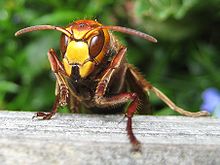- European hornet
-
For the main article see hornet. For the insect known colloquially in America as a hornet see Bald-faced hornet, and similarly for the Australian hornet.
European Hornet 
A female European hornet Scientific classification Kingdom: Animalia Phylum: Arthropoda Class: Insecta Order: Hymenoptera Family: Vespidae Genus: Vespa Species: V. crabro Binomial name Vespa crabro
Linnaeus, 1758The European hornet Vespa crabro, commonly known simply as the "hornet", is the largest European eusocial wasp. The queen measures 25 to 50 mm (1–2 in) long; males and workers are smaller. In males, as in most members of the Aculeata, the antennae have 13 segments, while in females there are only 12; also as in other aculeates, the male abdomen has seven visible segments, while the female has six; females possess an ovipositor modified into a sting which is not barbed. See wasp and bee characteristics to help identify similar insects.
This species will sting in response to being stepped on or grabbed. They are also defensive of their hive and rather aggressive around food sources such as lilac bushes. Care should be taken when encountered in these circumstances as they may sting without warning. The pain from the sting may persist for several days with attendant swelling.
Contents
Description
The eyes are deeply indented, shaped like a C. The wings are reddish-orange, while the petiolate abdomen is brown striped with yellow. The European hornet is larger than the common wasp, but smaller than some Asian hornet species. It has hair on the thorax and abdomen, although the European hornet is not as hairy as most bees.[1]
European hornets often have the rove beetle Velleius dilatatus living in their colonies.
Relationship with humans
Urban legends
European hornets (Vespa crabro) on nest.
European hornets are often mischaracterised as very aggressive and dangerous, and are greatly feared by some people. Some people believe that "three stings from the European hornet can kill an adult human, and seven can kill a horse". These are common myths - a sting from a European hornet isn't any more dangerous than any other wasp sting, and European hornets are less aggressive than other wasps. In contrast, multiple Asian giant hornets stings are, in fact, more dangerous. While impressive due to their size and loud sound, European hornets are in fact much less aggressive than some of their smaller relatives, such as the German wasp and the common wasp. When approached, European hornets can actually be seen to slowly crawl backwards and eventually flee, rather than attack. This can make it hard to remove hornets from indoors, if they happen to come in through an open window or door. While not aggressive when encountered far from the nest, multiple workers will vigorously defend the nest if provoked. Nests can be approached without provocation (by moving slowly and not breathing towards the nest) to about 50 cm (20 in). Nests are usually not a problem outside buildings, but because they drip faeces, a bad-smelling black liquid, nests inside sheds or walls can be a problem.
Endangered species and legal protection
Unwarranted fear has often led to the destruction of nests, leading to the decline of the species, which is often locally threatened or even endangered. European hornets benefit from legal protection in some countries, notably Germany, where it has been illegal to kill a European hornet or nest since 1 January 1987, with a fine of up to 50,000 Euros.[2] In Australia however, they represent a noxious introduced species and thrive in the warmer conditions, often reaching minor plague proportions during hot, dry summers.
Attraction to lights and food
European hornets are attracted to lights at night, but are not attracted to human foods and food wastes. However, they can totally destroy fruits, such as apples, while the fruit is still on the tree. This is quite unlike the bald-faced hornet or other social wasps.
Problems associated
European hornets are carnivores and eat many species of insects. Many of these insects are considered pests in the garden, which indicates that the hornet provides a benefit to the average garden/farm. For this reason it is suggested that you do not attempt to kill the hive. However, they are known to eradicate domestic honeybee hives, resulting in fewer honeybees for open pollination. They also tend to girdle branches, which results in dead branches.[3]
Geographic colour forms
European hornets worldwide are found with geographic colour forms:[4][5]
- Vespa crabro crabro Linnaeus, 1758
- Vespa crabro vexator Harris, 1776
- Vespa crabro germana Christ, 1791
- Vespa crabro crabroniformis Smith, 1852
- Vespa crabro borealis Radoszkowski, 1863
- Vespa crabro oberthuri du Buysson, 1902
- Vespa crabro flavofasciata Cameron, 1903
- Vespa crabro altaica Pérez, 1910
- Vespa crabro caspica Pérez, 1910
- Vespa crabro chinensis Birula, 1925
See also
Notes
- ^ "European Hornet". http://pubs.ext.vt.edu/2911/2911-1422/2911-1422.html.
- ^ "Hornets are worthy of protection!". http://www.vespa-crabro.de/hornets3.htm.
- ^ http://www.ca.uky.edu/entomology/dept/entfacts.asp
- ^ V. Dubatolov, J. Kojima, J. M. Carpenter, A. Lvovsky (2003). "Subspecies of Vespa crabro in two different papers by Birula in 1925". Entomological Science 6 (2003): 215–216. doi:10.1046/j.1343-8786.2003.00037.x.
- ^ J.M. Carpenter, J. Kojima (1997). "Checklist of the species in the subfamily Vespinae (Insecta: Hymenoptera: Vespidae)". Natural History Bulletin of Ibaraki University 1 (1997): 51–92.
External links
Categories:
Wikimedia Foundation. 2010.





